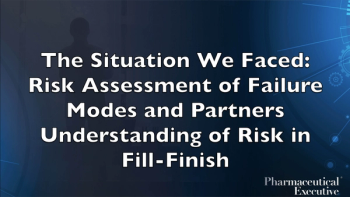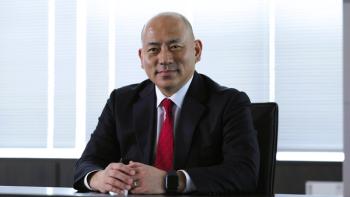
One Mechanism of Action Targets Numerous Oncology Indications
A Q&A that discusses challenges of biopharmaceutical entrepreneurship in the oncology indication and the opportunities for successful therapeutic development.
Biopharmaceutical entrepreneurship in the oncology indication is a significant challenge; however, if done
correctly, can offer many opportunities for successful therapeutic development. James Dentzer, President and CEO of Curis, will discuss how Curis managed to take a targeted mechanism of action with the potential to apply the therapy to numerous cancer types, and strategic business and financial decisions that are leading to a robust clinical development pipeline.
Moe Alsumidaie: What is different about the oncology work happening at Curis and what is the aim of your enterprise?
James Dentzer: There are several things that make Curis unique. We have three programs in the clinic. All three are novel, first-in-class, oral therapeutics; all three hit previously unhittable targets; and all three are potential blockbusters, meaning they have the possibility of achieving revenues greater than a billion dollars.
MA: What are the targets for your three programs?
JD: Our lead candidate, fimepinostat, targets Myc, a classic oncogene that has been studied for over 40 years by many companies and academic labs. In that time, none of those efforts has been successful in targeting and blocking Myc. Until now, and Curis is the first.
Our second asset, CA-4948, targets IRAK4 (interleukin-1 receptor-associated kinase 4), a critical component of the myddosome complex in the toll-like receptor (TLR) pathway. When this pathway becomes overactive, the result is cancer. We have found that by inhibiting IRAK4, we can shut down the myddosome, which in turn shuts down the TLR pathway. This should be similar to the impact ibrutinib has on a parallel pathway with BTK (Bruton tyrosine kinase). The TLR pathway and the BTK pathway come together at nuclear factor-κB and lead to B cell proliferation. Think of it as a sink with two faucets, hot and cold. Ibrutinib turns off the hot, and we turn off the cold.
Our last program, CA-170, is a dual checkpoint inhibitor hitting both VISTA (V-domain immunoglobulin (Ig)-containing suppressor of T-cell activation) and PDL1 (programmed death-ligand 1). There are lots of drugs right now targeting PDL1 or PD1, but they are all monoclonal antibodies that require repeated IV infusions. Ours is an oral small molecule, a pill. It is also the only anti-VISTA drug in the clinic. Many companies are researching VISTA. However, we are the only ones with a drug already in the clinic.
MA: What toxic side-effects are you experiencing with your candidates in the clinic?
JD: To date, all of our drug candidates demonstrate a nice safety profile. The question for us is: can we maintain that safety profile and also get the efficacy that we've seen in pre-clinical testing.
MA:That’s tough to achieve.
JD: It's tough, but that’s the name of the game. We're chasing targets nobody has successfully targeted before. If you do a search on “Myc,” one of the first things you find is the word “undruggable.” We have enrolled over 200 patients in clinical studies and, in our targeted patient group, have shown objective tumor shrinkage in 23% of those patients (note: objective shrinkage is a 50% reduction in the cross-section of a tumor and a 65% sustained reduction in tumor volume over time). Even better, we can maintain that shrinkage for a median of 13.6 months. These are incredible data considering how poorly Myc-driven cancers respond to the current standard of care (chemotherapy). No one has ever seen this level of clinical success with Myc before. We're excited about it.
MA: And in which tumor types is Myc-targeting relevant?
JD: Myc is a transcription factor gene. Effectively, it’s an instruction set that helps cells multiply very quickly. It is a critical gene that is turned on during the human embryo stage but mostly turned off after birth. One exception to that is in cancer cells. They need the Myc gene turned back on to support rapid tumor growth. Many different types of cancer are at least partially driven by Myc. We believe a drug that successfully suppresses Myc could help patients across many types of cancer. And we believe our approach is groundbreaking.
MA: In Q4 2018, you made some announcements on increasing focus on clinical operations. Could you elaborate on this decision and how the actions taken by the company will help Curis accomplish this goal?
JD: In Q4, we made some critical resource allocation decisions. Our previous strategy focused on utilizing our high-caliber discovery research engine to expand our pipeline of clinical programs continually. Thanks to that effort over the past three years, we now have a pipeline of three strong drug candidates that, assuming successful clinical trials. That is the critical task for 2019 –efficient execution on all three clinical programs. To ensure we have the resources to manage three clinical trials simultaneously, we needed to make some tough decisions in other areas of our business. We ended up cutting back significantly on early-stage discovery research and increasing the resources spent on clinical operations. In total, we were able to strengthen our clinical efforts and still secure a 28% reduction in total company cash burn.
MA: One of your molecules CA-170 is undergoing evaluation in a study that is run by your partner Aurigene. What are the challenges and opportunities in working with another enterprise to run studies?
JD: One of the things that make biotech different from other industries is that we have many more collaborations. In a heavily regulated environment, where most companies are small and do not have the resources of a multi-billion-dollar company, partnerships are incredibly helpful. In our case, we have partnered with Aurigene to study CA-170 in global clinical trials. We run trials in the US and Europe, and they run trials in India. Studying CA-170 in a global manner allows us to see how the drug performs in diverse populations. The secret to a successful collaboration is, of course, constant communication. Running a global clinical trial can be very complicated. Whether it is among different teams at the same company or with a partner’s teams on the other side of the world, good communication is the key to success.
MA:What are some of the general challenges that face small biotech companies? What is some of the other advice that you'd like to touch upon?
JD: The challenges facing Curis are the challenges every biotech company faces in the critical years before regulatory approval. To be successful, you need to be disciplined about drug development. Specifically, you need to select the right targets, design the right drugs, and study the right patients. Those sound like easy things to do, but they're not; especially when you have limited resources and a limited budget. Companies like Curis continually adjust resource allocation in response to the latest advances in the clinic. To some extent, it's both a science and an art.
MA: Do you think there's a perseverance aspect to it as well?
JD: Absolutely. There aren't very many biotech companies that make it to the 20-year mark, as Curis has. Part of our success has been the legacy of Curis employees over the past 20 years, who through their scientific brainpower and innovation continually found ways to crack the most uncrackable problems of biology, including discovering and bringing multiple drugs to the clinic, one of which is now a successful commercial product helping thousands of people. That legacy continues today with our current crop of employees. We are targeting pathways nobody else has successfully targeted before. We are excited by the challenge and are proud of what we have already accomplished. Our work is a life or death struggle, not just for the company but for patients all over the world. Moreover, we aim to win.
Moe Alsumidaie, MBA, MSF is Chief Data Scientist at Annex Clinical.
Newsletter
Lead with insight with the Pharmaceutical Executive newsletter, featuring strategic analysis, leadership trends, and market intelligence for biopharma decision-makers.




